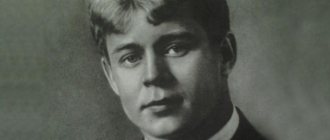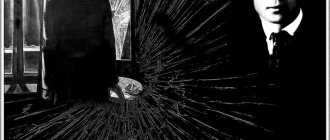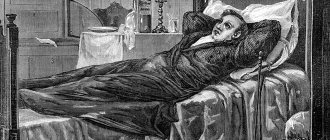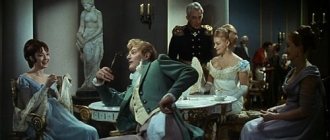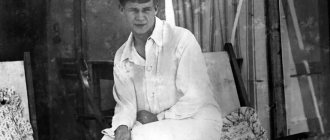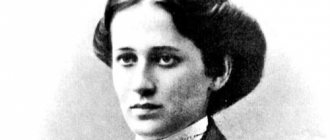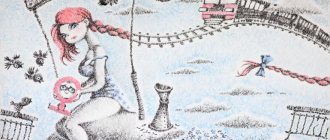The poem “Anna Snegina” is iconic in the work of Sergei Yesenin. Firstly, this work was largely autobiographical, and secondly, it was written in January 1925, shortly before the poet’s death. Before his death, he thought a lot about events that had a colossal impact on the history of Russia. The poem “Anna Snegina” is, in fact, the fruit of Yesenin’s rethinking of the October Revolution and its very ambiguous consequences for the common people. In his work, he acted not so much as an outside observer, a storyteller, but rather in the role of a simple, “little” person who became a hostage to fatal circumstances.
History of creation
Russia entered the twentieth century as a country with a very low level of universal literacy. This fact could not go unnoticed for a long time, and soon political parties began to form in the country, and ordinary people gradually began to take part in the public life of the country. This period was very difficult for the Russian Empire, which for several years (1914-1918) took part in the First World War. Immediately after its end, the Civil War began in the country, marking the collapse of the old life and the formation of a new world order.
Sergei Yesenin was a direct witness to all the global changes that reigned in the country. He could not remain indifferent to the fate of his homeland, and described his own experiences in the poem “Anna Snegina”. He described the turning point in the history of Russia through the prism of the fate of a “little” man. The poet managed to emphasize the drama of the era with the help of a special meter of verse - amphibrachic trimeter, which Nekrasov so loved to use in his works of an accusatory nature.
The events of the poem cover the time period from 1917 to 1923. Yesenin described a real area in Russia: “The village, then, is our Radovo...”, and this choice was not accidental: in the poem, Radovo became the prototype of Konstantinovo, the writer’s homeland. In reality, there is also the village of Kriusha, whose name the author changed to Kriushi. It is located in the Klepikovsky district of the Ryazan region, not far from the Rybnovsky district, where the village of Konstantinovo is located.
Sergei Yesenin began working on the poem in 1924, during his trip to the Caucasus. This period was very fruitful in the work of the poet, who worked with great passion and joy. The fruit of his labors was a lyric epic, largely autobiographical poem. It is interesting in its originality, since it combines two types of literature at once: epic (historical events) and lyrics (the hero’s love experiences).
What is the poem about?
The poem "Anna Snegina" consists of five chapters, and each chapter reflects a certain period in the history of Russia. The peculiarity of the composition of the work lies in its cyclical nature: the poem begins and ends with a description of the protagonist’s arrival in his native village.
- In the first part, the narrative begins with a description of the First World War, into which Russia was also drawn. The narrator bitterly describes the drama of ordinary soldiers who find themselves in the role of “cannon fodder,” while seven of them are forced to work up a sweat to feed the army. The hero returns to his homeland, and, having talked with the driver, reports that he deserted and returned to his native place in order to take a little break from wanderings and trials.
- The second part is a detailed commentary on important historical events in the country. The characters - the miller, his wife and Sergei - lament the terrible changes that have taken place in Russia and predict even darker times for the country. Sergei remembers Anna Snegina, with whom he was once in love. Now the girl became the wife of a local nobleman who was called to the front. He decides to meet with his former lover, and the characters spend the whole day discussing their emotional experiences.
- The third part is entirely devoted to the relationships of the main characters, who were still connected by their former tender feelings. Meanwhile, a revolution occurs, and the peasants begin to demand land from the landowners. The ensuing drama is further intensified by the news of the death of Anna's husband. In her hearts, the young woman accuses Sergei of cowardice and desertion. The heroes have a big fight, and a rift occurs between them.
- In the fourth part, Anna and Sergei are reconciled. Meanwhile, a full-scale nationalization of noble lands is unfolding in their area. Anna Snegina, in search of a safe place, moves to a kind-hearted miller, where she meets Sergei. The young woman shares her feelings and experiences with him, asks for forgiveness for the unfair accusations against him, which were made in a moment of great despair. As a result, Sergei goes to St. Petersburg to find out from reliable sources what is happening in the country.
- The fifth part describes the end of the Civil War. The narrator is deeply shocked by how his country has changed: having survived the meat grinder of a fratricidal war, Russia is mired in poverty and rampant crime. He decides to return to Radovo again, where he learns about Anna's emigration. Despite the strong feeling, the hero cannot follow her, because he loves his homeland with all his heart.
Essays
Anna Snegina is the last major work written by Yesenin. In it, the writer reflected his memories of the past, his love, comprehended the revolutionary events and shared his vision with the reader.
Anna Snegina brief analysis
Analyzing Sergei Yesenin's poem Anna Snegina, we see that it consists of five chapters. Each part refers to a certain stage in the life of the country, where, against the backdrop of unrequited love, we observe wars and revolutions.
Genre and composition
Following the hero's story, we find ourselves in the native village of the young poet Sergush. He is tired of the turbulent events in St. Petersburg associated with the revolution, so he decides to take a break from all this. Arriving in the village, the poet finds himself in a different place, unlike the one he left. The hero observes the unbearable burden that fell on the shoulders of ordinary people who now had to feed the soldiers. Because of this, devastation and disunity between residents reign everywhere.
In the poem we see other heroes, the miller and the miller's wife, who, together with Sergusha, complain about disasters, sharing their gloomy forecasts. The lyrical hero saw how much the political situation influences people, changing them. The hero also remembered his past love, landowner Snegina, who married someone else. Her husband is now at the front, but Sergusha suddenly wanted to meet.
Studying the poem by Anna Snegina, and presenting a brief analysis of it, I would like to mention the relationships of the heroes and their mutual sympathy. Against the backdrop of all this, the author shows popular unrest. There is a riot in the village of Kriusha. The peasants demand the land of the landowners. They also came to Anna, forcing her to give up her possessions. Just at this time, the woman learns about the death of her husband. This news broke Anna Snegina; she begins to accuse Sergusha of cowardice, who, unlike her husband, fled from the front.
Meanwhile, nationalization continues. Snegina has to move to the miller, where she and Sergush reconcile. But they are not destined to be together. The woman goes abroad, but the hero returns to St. Petersburg.
At the end of the poem we see the end of the civil war and the consequences that it left behind. Sergei returns again to the village of Radovo, which has become unrecognizable. There he receives news of his beloved’s safe emigration, but he himself is not ready to go after her. His heart belongs to his native land, to the Motherland, which he loves and is not ready to leave.
As we can see, the composition of the poem is cyclical. At the same time, Yesenin creates a plot in the genre of a lyric epic poem, although many researchers claim that the work may well be a short story in verse, or a poetic story.
In the analysis of the poem by Anna Snegina, it is necessary to mention the topics that the writer touched upon. These are the themes of love, Motherland, the theme of revolution and war. Expanding the theme of Anna Snegina's poem, the author shows problems such as social inequality, the problem of betrayal, cruelty, fidelity and a sense of duty.
History of creation
The poem was published during the period when Yesenin was in the Caucasus. At that moment, the poet easily managed to write his works, so Anna Snegina was written in one go. This happened in 1924. This work can be considered autobiographical, and it represents the poet’s reflections on a critical and dramatic time.
The meaning of the title of Yesenin's poem
As we have already said, in Anna Snegina’s work Yesenin turned to the time of troubles, where from 1917 to 1923. The usual life in the country is collapsing. The people are in the very center of upheaval. The writer tries to reflect on his fate, expressing his attitude to what is happening, and believing that spiritual and moral values cannot be replaced by social ones. The main goal of the poem is to show the theme of human destiny, and the image of Anna Snegina has become a symbol of lost youth. Her name embodies something bright and pure, like snow, where the heroine herself became a hostage of that fateful era.
Save it to your wall so you don’t lose it!
The main characters and their characteristics
- The narrator is the main character in the poem, a young man named Sergei. This is an intelligent, thinking, observant person who has a lot in common with Yesenin himself: for example, he came from a simple peasant family, but was able to break out into the people by leaving for the capital and becoming a famous poet. Sergei returned to his native village as a famous, respected man, but he was never able to get rid of his youthful complexes: he could not forget the humiliations that he experienced because of his unenviable origin. Numerous insults hardened his soul and caused him to lose faith in people. It was for this reason that Sergei initially avoided communicating with Anna: he believed that his noble and wealthy lover only wanted to amuse her own vanity by getting closer to the capital’s literary bohemia. The main character sincerely loves and has a keen sense of nature, and with great pleasure glorifies the beauty of his native land in his works. Being a humane person, Sergei is horrified by the events taking place: he denies the war with its mercilessness and senseless bloodshed, and therefore runs away from the front. He is outraged by the injustice reigning in the country. After all, while the common people were shedding their blood, rich and noble people were holed up in safe places and only talked about patriotism. At his core, Sergei is a rebel, but his protest is not just an emotional outburst, but a deliberate, meaningful act of a person capable of analyzing and reasoning. At the same time, the main character has a soft, lyrical disposition. Tired of frightening changes, he dreams of hiding from reality in bright memories and dreams. Immersed in nostalgia, Sergei seems to be observing from the outside the social and political changes taking place in the country, which, like scenery in a theater, replace each other. The young man is frankly frightened by these changes, and he finds refuge in dreams of a happier, more serene life. When describing the hero, the author deliberately uses the antithesis “then - now”. Sergei really wants to understand the current situation, and therefore constantly compares the past and present. In an attempt to independently reassess new circumstances, the hero does not think about the future: he seems to flow with the flow of life, observing, analyzing and drawing his own conclusions about what is happening.
- Anna Snegina is a young beautiful girl, a representative of the noble class. Anna was Sergei’s first great love, and her prototype was Lydia Ivanovna Kashina, a girl who played a great role in Yesenin’s life in his early years. Due to external circumstances, their relationship was never able to develop, and the young people met again at the very height of the revolution. This chance meeting was of great importance for the poet. In reality, Lydia Kashina did not emigrate, but, having transferred the estate to the peasants, moved to Moscow and began working as a typist. Yesenin introduced the image of this woman into the work for a reason - for him it became the embodiment of the protagonist’s break with the past, which had no chance of being realized in the present. This is why Anna leaves Russia - for many reasons, the hero simply could not build a happy life with her in the conditions of a renewed Russia. But what is Anna Snegina like? She was a beautiful young woman, a noblewoman, who received an excellent upbringing and education. In her youth, she was a naive girl, open to the world, but with age she realized her class superiority. This understanding was further strengthened after a profitable marriage. Seeing Anna after a long separation, Sergei was not immediately able to recognize in the smartly dressed lady with the manners of a socialite the girl with whom he had once been passionately in love. Anna was very flattered by her close acquaintance with the famous poet, and notes of coquetry involuntarily slipped into her behavior. The meeting with Anna awakens in the narrator a former love, which all this time lived only in memories. The heroine’s surname, Snegina, was also chosen for a reason: she personifies the snow-white purity and purity of snow covers, and this effect is enhanced by Anna’s attire (white dress, white gloves and shawl).
- This whiteness remains for the hero unsullied by the bloodshed that is tearing the country apart. She blinds him and gives him the desired oblivion. However, in choosing between white and red, Sergei gives preference to the latter, because his peasant origin once said “yes” to a girl in a white cape. Anna herself declares her rejection, accusing the guest of desertion. In the finale, they make peace, telling each other about their feelings, but social inequality again separates them: Snegina leaves because she does not find a place for herself in the new realities. She is a symbol of Russia’s past, which the author loves so much.
- Pron Ogloblin
is a Bolshevik, a peasant, the negative hero of the poem “Anna Snegina”. Its prototype was Pyotr Yakovlevich Mochalin, a fellow villager of Yesenin. He was a staunch representative of the left, survived the revolution and took up party work in the regions. Pron, on the other hand, is different from his inspiration: he is more aggressive and impudent, he has a clear penchant for violence, because he ended up in hard labor for murder. This is how the miller’s wife described the character: “A bully, a brawler, a brute. He’s always angry with everyone, Drunk every morning for weeks.” He was in hard labor, but after a series of revolutionary events he returned to Radovo and began to promote socialism among the peasants. He is obsessed with the idea of rebellion and the division of noble estates. In conclusion, he became even more convinced that the uprising would save the country. In his image, the author portrayed a romantic revolutionary: he really sincerely believes that only radical changes will help the people gain justice and equality. He backs up his idea with actions, rousing his fellow villagers to revolt, instilling in them “revolutionary consciousness.” He goes to his death for his activities; he was shot by whites during the Civil War. - Labutya
is Pron's brother. He took part in the Russo-Japanese War of 1904-1905, here the poet mentions “the surrendered Port Arthur” with the siege of which the first hostilities began; on the night the Japanese attacked the Russians without declaring war, which speaks of their cowardice. Labutya was awarded two medals, but even with them on his chest, he remains a “devilish coward.” It is he who goes first to describe Snegin’s house - “there is always speed in capture.” He is the opposite of his brother, although he accepts the revolution. In this image, the poet portrays a pragmatic rebel who takes only benefits from the ideological struggle that are beneficial to himself, but does not share its ideas. He cowardly hides in a haystack when the whites shoot Pron, but then demands an order for courage. The images of heroes in the poem “Anna Snegina” associated with the revolutionary coup are used by Yesenin to characterize what happened in Russia is ambiguous: since the coup was carried out by such different people, it could not turn out either good or bad. It is as versatile as its members. - The miller
is an optimist and a cheerful fellow. This person courageously and with dignity accepts the blows of fate, but does not attach much importance to them, reducing everything to a joke. He does not divide people into whites and reds; he welcomes both peasants and Snegins equally cordially. He is distinguished by his hospitality: he treats the narrator, gives shelter to Anna and her mother, etc. All the main characters of Yesenin’s poem find consolation and an opportunity to unwind from him. This is genuine national character in its best manifestations - in mercy, in kindness, in Christian love for one's neighbor. - Snegina’s mother
is a sensible and cold-blooded woman, whose temper has become hardened under the appropriate conditions. She accepts her son-in-law's death stoically and brings her daughter back to her senses without losing her composure at all.
Anna Snegina
The action takes place on Ryazan soil from the spring of 1917 to 1923. The story is told on behalf of the author-poet Sergei Yesenin; the image of “epic” events is conveyed through the lyrical hero’s attitude towards them.
The first chapter talks about the poet’s trip to his native place after the hardships of the world war, in which he was a participant. The driver talks about the life of his fellow villagers - wealthy Radov men. The Radovites are constantly at war with the poor village of Kriushi. Neighbors steal timber, create dangerous scandals, one of which ends with the murder of the foreman. After the trial, the Radovites “began to have troubles, the reins of happiness slipped away.”
Continued after advertisement:
The hero reflects on his disastrous fate, remembering how he shot “for someone else’s interest” and “climbed his brother with his chest.” The poet refused to participate in the bloody massacre - he straightened his “linden” and “became the first deserter in the country.” The guest is warmly welcomed into the miller's house, where he has not been for four years. After the samovar, the hero goes to the hayloft through a garden overgrown with lilacs - and “the distant dear ones” appear in his memory - a girl in a white cape, who said affectionately: “No!”
The second chapter tells about the events of the next day. The hero, awakened by the miller, rejoices in the beauty of the morning and the white haze of the apple orchard. And again, as if in contrast to this, thoughts about the cripples innocently disfigured by the war. From the old miller's wife, he again hears about the clashes between the Radovites and the Kriushans, that now that the tsar has been driven out, “freedom is abhorrent” is happening everywhere: for some reason, the forts were opened and many “thieves’ souls” returned to the village, among whom was the murderer of the elder Pron Ogloblin. The miller, who has returned from the landowner Snegina, an old acquaintance of the hero, reports how much interest his message about the guest who came to him aroused. But the miller’s sly hints do not yet confuse the hero’s soul. He goes to Kriusha to see some men he knows.
Briefly exists thanks to advertising:
A peasant gathering gathered at Pron Ogloblin’s hut. The peasants welcome the capital’s guest and demand that all the burning questions be explained to them - about the land, about the war, about “who is Lenin?” The poet replies: “He is you.”
The third chapter contains the events that followed a few days later. The miller brings Anna Snegina to the hero who caught a cold while hunting. The half-joking conversation about young meetings at the gate, about her marriage irritates the hero, he wants to find a different, sincere tone, but he has to obediently play the role of a fashionable poet. Anna reproaches him for his dissolute life and drunken brawls. But the hearts of the interlocutors speak of something else - they are full of the influx of “sixteen years”: “We parted with her at dawn / With the mystery of her movements and eyes...”
Summer continues. At the request of Pron Ogloblin, the hero goes with the peasants to the Snegins to demand land. Sobs can be heard from the landowner's room - the news has come about the death of Anna's husband, a military officer, at the front. Anna does not want to see the poet: “You are a pathetic and low coward, he died... And you are here...” Stung, the hero goes with Pron to the tavern.
The main event of the fourth chapter is the news that Pron brings to the miller's hut. Now, in his words, “we’ve got everyone ready - and kvass! in Russia there are now Soviets and Lenin is the senior commissar.” Next to Pron in the Council is his brother Labutya, a drunkard and talker, who lives “without a callus on his hands.” It is he who goes first to describe Snegin’s house - “there is always speed in capture.” The miller brings the mistresses of the estate to him. The hero's final explanation with Anna takes place. The pain of loss and the irrevocability of past relationships continue to separate them. And again only the poetry of memories of youth remains. In the evening the Snegins leave, and the poet rushes to St. Petersburg to “dispel melancholy and sleep.”
Continued after advertisement:
The fifth chapter contains a sketch of the events that took place in the country in the six post-revolutionary years. The “grimy rabble,” having seized upon the master’s goods, strums the piano and listens to the gramophone—but “the grain grower’s lot is dying out,” “fefela!” Breadwinner! Iris!" for a couple of battered “kateks” he allows himself to be torn out with a whip.”
From the miller's letter, the hero of the poem learns that Pron Ogloblin was shot by Denikin's Cossacks; Labutya, having survived the raid in the straw, demands a red order for his bravery.
The hero again visits his native places. The old people greet him with the same joy. A gift has been prepared for him - a letter with a London seal - news from Anna. And although outwardly the addressee remains cold, even a little cynical, a mark still remains in his soul. The final lines again return to the bright image of youthful love.
Themes:
- Homeland theme.
Approaching the village of Radovo, the hero of the poem “Anna Snegina” abstracts himself from past negative thoughts associated with the war and begins to describe everything that happens to him, in particular nature. Sergei loves and feels her subtly: “The moon showered the distant villages with golden powder.” For him, his native land is the beauty of Russian open spaces, which he not only admires, but also lives. In it he seeks salvation from the cruel historical realities. However, his feeling of patriotism arises precisely in the wilderness, far from political intrigues. For example, Moscow is mentioned in the work only once during a conversation with a miller, but the poet does not characterize the city in any way: “This summer we have more than enough mushrooms and berries in Moscow.” He is indifferent to him, but he is kind to his small homeland. Although he fled from the front, not feeling what he was fighting for, he did not leave Russia in its bloody struggle, did not follow Anna to London. In this courageous act - to stay with the homeland to the end - the true patriotism of the hero is manifested. - Theme of war.
Yesenin does not accept the war, he feels hostility towards it, like the peasants, for him it is a national disaster. The soldier feels like a “toy” in the wrong hands, this is not his war, he does not see the meaning in it. - Theme of revolution.
The attitude towards her in the poem “Anna Snegina” is very negative. That is why the peaceful past is idealized. The revolution and the new government in the work are presented as a fatal demonic force that destroys the destinies of people. Post-revolutionary Russia has become like a kind of circus, where the “grimy rabble” looks very clumsy and caricatured in the eyes of the lyrical hero, playing pianos in the courtyards and listening to the gramophone. There was chaos and lawlessness in the country. - Theme of love.
Sergei and Anna Snegina, of course, love, but do not understand what exactly: the past or the present in each other? They seem to want to start all over again, but their feelings are only alive in memories. In addition, ideological barricades separate them. The narrator goes to deprive the landowner of her land, and she receives news of the death of her husband - on the very front from which her former lover fled. This situation put everything in its place: the heroine, although she consoles herself with illusions, has still changed a long time ago, and in relation to the boyfriend of her youth she behaves differently than a loving woman might. The images of a girl in a white cape, a landowner who reproaches Sergei, and Anna, who writes from emigration, seem to live a separate life. The thematic lines of the poem are associated with three different female faces - past, present and future tense, which form a three-dimensional space - a blooming garden, a revolutionary village, alien London. So, the narrator remains forever in the blooming garden, avoiding other facets of space. He only loves the past, because he missed the present without regret, and he will not go to England for the future. But he is ready to relive the youthful years spent at the gate again and again. - Leitmotif of the road
. “And now I’m on the road again,” says the narrator. The image of the path is one of the oldest in world literature; examples of this are the works: “The Captain’s Daughter”, “Hero of Our Time”, “Dead Souls”. The motif of the road helps to better reveal the inner world of the narrator, because it is the path that helps him think about the meaning of life and makes him feel the beauty of the surrounding landscape. - The epic theme
is revealed in the poem “Anna Snegina” in a retrospective manner of presentation. Sergei recalls his youthful love, the time when life was carefree. This retrospective view is maintained from the first to the last lines. The past is very important for the author and the lyrical hero. The past is viewed as something abstract, but even despite this, it does not lose its significance: the event, the fact, and not a specific date is of fundamental importance. This is indicated by the frequently used adverbial indefinite adverb “once” in the text, which appears 4 times in the work. The adverbial adverb of time “recently” is found less frequently—once. And the unchangeable adverb “now” creates the antithesis of the adverb “once upon a time.” All this suggests that time is not concrete, but rather metaphorical. It is abstracted from reality. Memories are valuable to the storyteller. This is the past that left a mark on his soul: “I now remember...”. Flashbacks are a character's way of explaining reality to themselves. To show the uniqueness of the past days, the author uses the simple word “truth,” thereby indicating the authenticity of the events: “they were sweet,” “I would have known a happy true story.”
Poem "Anna Snegina". Lyrical and epic in Yesenin’s poem. - presentation
Poem "Anna Snegina". Lyrical and epic in Yesenin's poem.
You read the poem yourself. Share your impressions. What is this poem about?
In fact, this is Yesenin’s most striking and major work, not only about first love. The main action takes place from spring to late autumn of 1917, during the Russian Revolution. The “peasant wars” of two neighboring villages, the wealthy Radov and the land-deprived Kriushi, the causes of the village “disorders,” the seizure of the landowner Snegina’s estate and other events are assessed here in different ways by different characters. It is also significant that the poem about the revolution talks about love that was not reciprocated. This gives the work a special ambiguity and helps Yesenin, for the first time in the literature of the 20s, approach the topic of revolution, emigration and disunity of the Russian intelligentsia from the standpoint of national and universal values.
The poem “Anna Snegina” was written in early 1925. In her comments to the poem, S.A. Tolstaya-Yesenina emphasizes: “Anna Snegina” is largely autobiographical... Yesenin spent the summer of 1918 in Konstantinov and, of course, was an eyewitness to the phenomena taking place in the revolutionary village. The connection of this work with reality is easy to trace even from a number of details. For example, the names of the villages Kriushi and Radovo... Two villages with such names exist in the area around the village of Konstantinovo.
Anna Snegina has a prototype. The sister of the poet A.A. Yesenin calls Lydia Ivanovna Kashina, “a young, interesting and educated woman,” and writes: “She was the prototype of Anna Snegina...
words in the poem “Anna Snegina”: We have arrived. House with a mezzanine The facade has squatted a little. Its wattle palisade smells excitingly of jasmine – it belongs to the estate of Lydia Kashina.”
The poet had a friendship with Lydia Ivanovna Kashina. The girl’s father owned an estate in Konstantinov, Yesenin’s native village, the Bely Yar farm, forests beyond the Oka, stretching for tens of kilometers deep into Meshchera, as well as rooming houses in Moscow on the Khitrovy market. In the book “Moscow and Muscovites,” V. Gilyarovsky wrote that “the entire police was afraid of the owner of the main slum in Moscow with his millions,” because “the governor general shook hands with Ivan Petrovich.”
L. Kashina was a beautiful and educated woman. In 1904 she graduated with honors from the Alexander Institute of Noble Maidens and spoke several languages. Yesenin often visited her house, where literary evenings and home performances were held.
“Our mother,” recalled the poet’s sister, “didn’t like the fact that Sergei got into the habit of going to the lady... “Of course, I don’t care, but I’ll tell you what: leave this lady, she’s not a match for you, there’s no point in going to her “... Sergei was silent and went to the manor’s house every evening... The mother no longer tried to talk to Sergei. And when Kashina’s little children brought bouquets of roses to Sergei, she just shook her head. In memory of this spring (1917), Sergei wrote Kashina’s poem “Green Hairstyle...”
However, the image and fate of the mistress of the Konstantinovsky estate differ in the main thing - in relation to the revolution. If the heroine of the poem does not accept the revolution and leaves Russia, then Kashina herself handed over the house to the peasants in 1917 and moved to Moscow, where she worked as a translator, typist and stenographer.
But Yesenin wrote his heroine not only with Lydia Kashina. The origin of the heroine's name and surname also has its own history. It is no coincidence that the name Anna, which means “rich, wonderful, grace, comeliness,” coincides with the name of Anna Alekseevna Sardanovskaya, the great-niece of the priest of the village of Konstantinovo. The poet was also fascinated by her in his youth. Anna Sardanovskaya resembles the “girl in a white cape” by name, age, memorable feature of her appearance - dark skin (“dark hand”) and even because she loved white dresses and white flowers.
In addition, she was the girl who fell in love with another and tenderly said “no” to the poet. Sardanovskaya's early death (she died in childbirth on April 7, 1921) shocked Yesenin and romanticized her image as the image of the only true love. I. Gruzinov recalled that in the spring of 1921 Yesenin told him: “I had true love. To a simple woman. In the village. I came to see her. He came secretly. I told her everything. Nobody knows about this. I've loved her for a long time. I'm sad. It's a pity. She died. I have never loved anyone so much. I don't love anyone else."
But the most amazing coincidences exist with the third woman, who “gave” Yesenin’s heroine her surname. This woman is the writer Olga Pavlovna Sno (1881–1929), who signed her works “O. P. Snegina”, “Olga Snegina”, “Snowflake”, etc. Yesenin and O. Snegina met in April 1915 in her literary salon. Snegina’s dedicatory inscription on the book “Stories” (1911) is known: “To Spring Yesenin for his “Rus”. Love Lisa from Moroshkino and me. 1915, April. Olga Snegina."
We are talking about Yesenin’s small poem “Rus” and the heroine of the story “The Village of Moroshkino”, placed in the book given to Yesenin and highly appreciated by M. Gorky in a letter to the author. It is curious that the pseudonym “Snegina” is a translation of the surname of her husband, writer, Englishman by birth E. Snow (snow - translated from English - snow). So that’s where Yesenin’s poem mentioned the “London seal” on Snegina’s letter! He could see this seal on letters sent by her relatives from England.
How did you determine the genre of the work?
Yesenin himself defined the genre of “Anna Snegina” as a lyric epic poem. How do you understand this definition?
But there are other views. V. Turbin, for example, calls the work “a story in verse” and finds similarities with “Eugene Onegin” by A. S. Pushkin.
Another definition was proposed by Kvyatkovsky, arguing that this is a poetic short story, that is, a narrative with an intense novel plot and an unexpected ending.
All these definitions indicate various features of the work, among which the lyrical and epic principles stand out more clearly, which determines the topic of today's lesson.
The main character bears the name of the author, but here Sergei Yesenin is not the author, but a hero, a former peasant, and now a famous poet, who came to the “bard’s estates” to relax and hunt. The lyrical plot of the poem is connected with them.
Let us comprehend the development of the lyrical plot of the work, following the author.
Work in pairs.
Work in groups. Level 1. List the means by which the poet captured the features of a difficult time. Level 2. How do you understand the meaning of the title of the poem. Show the relationship between the theme of the homeland and the theme of time. How is this expressed in a narrowly chronological sense?
Level 1. images of heroes, their remarks, stylistic features of speech, the fate of individual people, their attitude towards war and revolution. Level 2. The title suggests that everything main is concentrated in the poet and Anna Snegina and in the relationships that develop between them. Snegina is a symbol of purity and lost youth. In the story of one of the corners of the Russian land from 1917 to 1923, one can guess the life of all of Russia: war, revolutions.
Level 3. Confirm with the text that Yesenin does not idealize the peasantry and emphasizes its heterogeneity.
Write down the author's characteristics commenting on the relationship between Anna and Sergei.
Explain the purpose of repetition. Chapter 1: They were distant, dear ones - That image in me did not fade away... We all loved during these years, But they loved us little... End of the poem: They were distant, dear ones!.. That image in me did not fade away. We all loved during these years, but that means they loved us.
The repetition emphasizes the importance of the love plot and that the past and present are interconnected; it seems to connect times, emphasizing their inseparability from the fate of their native land.
Explain the reasons why historical events are shown sketchily, without depth.
Of particular interest is not the depiction of epic events itself, but the poet’s attitude towards them. Yesenin expresses the concept of life - his view of the world, of events, of what remains eternal and unshakable.
Level 4. Analyze the evolution of the character traits of the Russian peasant using the example of corresponding images. Analyze the reasons why the main characters cannot be together. Give the reasons why Yesenin shows different types of peasants who accepted the revolution.
The author of the poem seemed to warn what the Prons who had seized power and found themselves near the power of Labuti would be capable of. Yesenin was the first to talk about this.
Level 5. What do you think about the role of the miller in the poem? (He embodies the best features of the Russian national character: kindness, closeness to nature, mercy and humanity, constantly unites people.)
Level 5. Mednik embodies the best features of the Russian national character: kindness, closeness to nature, mercy and humanity, constantly connecting people.
Level 6. Express your attitude towards the lyrical hero. Rate the image of Anna Snegina.
Level 6. The lyrical hero has much in common with the author in his structure of thoughts, moods, and attitude towards the war and peasants. Through the attitude towards it, the image of the author is revealed. The heroine has a poetic, sublime nature, which makes her image attractive. Departure from Russia is the tragedy of Anna Snegina.
Draw a conclusion about what was included in the concept of “Motherland” in S. Yesenin’s poem.
For the poet, the homeland is not so much the state, territory, history and modernity, but rather the rich Russian soul, “directly corresponding to the people’s ideals.” Their spokesman for us is S. Yesenin himself.
The authors of the monograph on Yesenin, the Kunyaevs, claim that “Anna Snegina” is “Yesenin’s most anti-peasant poem.” Do you agree with this? Write a miniature essay, citing the text of the poem as arguments.
Issues:
- The problem of war
. The soldiers did not feel what they were fighting for, this is the reason for Russia’s loss in the First World War. Although the main character is a patriot, he still deserts, because he understands that this is not his fight, that he is simply being used. In addition, the author covers the issue more globally, saying that any bloody strife is a tragedy for the country and its inhabitants. The drama of military losses is especially felt when the Snegins received the news of the death of Boris. - Social inequality
in Yesenin’s poem “Anna Snegina” is the main problem. It was this that served as fertile ground for revolutionary sentiments that led to the civil war. It separated the main characters, embittered the narrator, and drove the peasants into a frenzy. - Problems of feeling and duty.
Anna Snegina feels sympathy for the narrator, but cannot betray her husband, and then the memory of him. The poet faces the same contradictions when he chooses between protecting the interests of the peasants and helping his former lover. - The moral and philosophical problem
of choice is manifested in the unclear position of the narrator: he does not understand which side of the barricade he occupies, and whether he needs it. Both sides inspire doubt in him, because the end does not justify the means, and justice does not justify violence. He experienced the same thing at the front when, loving his homeland, he refused to participate in the state’s war. - The problem of cowardice and betrayal
. Although Labutya readily learned revolutionary slogans, deep down he still did not live up to them. Such people were in all movements and parties; they were the ones who remained alive while their honest and brave comrades fought for the idea and died for it. - The problem of cruelty
. Although the Bolsheviks wanted to place justice and equality on the pedestal of public morality, they could not help but get their hands dirty in cruelty. For example, they evict the widow of a White Guard killed in the war from her house; they don’t care what happens to a defenseless woman who has experienced such grief. - The problem of power
. The poet in the book “Anna Snegina” comes to the conclusion that any power is the suppression of the individual, it is violence alien to the people. She clearly distinguishes between these concepts: “Since they are the authorities, then they are the authorities, And we are just simple people.”
Meaning:
Yesenin, first of all, set priorities for himself: what is on his way? Analyzing the situation that has developed under the influence of social cataclysms, he chooses for himself the good old past, where there was no such rabid hostility between family and friends. Thus, the main idea of the work “Anna Snegina” is that the poet does not find a place for man in the new aggressive and cruel reality. The struggle has poisoned minds and souls, brother goes against brother, and life is measured by the force of pressure or blow. Whatever ideals stand behind this transformation, they are not worth it - this is the author’s verdict on post-revolutionary Russia. The poem clearly indicated the discord between the official party ideology and the philosophy of the creator, and Sergei Alexandrovich was never forgiven for this discrepancy.
However, the author did not find himself in the emigrant lot. By showing disdain for Anna’s letter, he marks the gap between them, because he cannot accept her moral choice. Yesenin loves his homeland and cannot leave it, especially in this state. Snegina left forever, like the past, and for Russia the disappearance of the nobility is a historical fact. Even if the poet seems to new people to be a relic of the past with his snotty humanism, he will remain in his native land alone with his nostalgia for yesterday, to which he is so devoted. This self-sacrifice expresses the idea of the poem “Anna Snegina”, and in the image of a girl in a white cape, a peaceful patriarchal Russia with which he is still in love appears before the narrator’s mind’s eye.
Analysis 3
The poem not only shows events, but also, first of all, conveys the feelings of the characters. This is not so much about the revolution, but about Yesenin’s meeting with his first love.
It all starts with the poet’s reasoning about the First World War, to which he was sent, which is why he became the first, as he calls himself, deserter. And so, having escaped from the horrors of war for ideas and material values that were unnecessary to him, Sergei returns to his native place. He is immediately surprised by the behavior of the man who gives him a lift to the mill, and greedily demands more money for a good deed. Life in these places has become very difficult.
The miller and the old woman are very happy to see Sergei. The old man becomes the reason that Anna finds out about the poet’s visit and invites him to visit. Several times in the poem there is a memory of a conversation with Anna, more precisely, of a declaration of love to her. But she refused him. It turns out that she married a military man out of love, but some kind of tenderness and, perhaps, a feeling of guilt remained with her before Yesenin. They both think about how life could have turned out if they were together... But it turned out that he became a famous poet, she became an important lady. In principle, both are happy. He is not in love with anyone, and she is happily married.
When they see each other, they both feel embarrassed, both admire each other. It is especially easy for Anna to praise Sergei. The hero admits that the image of that love in him still has not faded away. At the same time, he understands that relations are impossible, including for political reasons. He is for Lenin, for the revolution, and Snegin now turns out to be an enemy of the people.
Soon Yesenin becomes a witness to revolutionary events. He sees how ordinary people, offended by fate, simply want to take away Snegina’s estate. And that one is sad - her husband died, she even reproaches Yesenin that the poet is “cowardly” alive.
Yesenin leaves, and when he returns to these parts, the miller gives him a letter from Anna. She is abroad, even admires the new country, misses her native land, always remembers Yesenin as her first love.
Analysis of the poem by Anna Snegina according to plan
Criticism:
For the first time, fragments from the work “Anna Snegina” were published in 1925 in the magazine “City and Village”, but full-scale publication was only at the end of spring of this year in the newspaper “Baku Worker”. Yesenin himself rated the book very highly and said about it like this: “In my opinion, this is better than anything I’ve written.” The poet V.F. Nasedkin confirms this in his memoirs: “He most willingly read this poem to his literary friends then. It was clear that he liked it more than other poems.”
Critics were afraid to highlight such an eloquent reproach of the new government. Many avoided speaking in print about the new book or responded with indifference. But judging by the newspaper’s circulation, the poem aroused genuine interest among the average reader.
According to the Izvestia newspaper dated March 14, 1925, issue 60, we can establish that in the Herzen House, at a meeting of a group of writers called “Pass,” the first public reading of the poem “Anna Snegina” took place. The reaction of the listeners was negative or indifferent; during the poet’s emotional declaration they were silent and did not show any interest. Some even tried to call the author to discuss the work, but he sharply rejected such requests and left the hall in upset feelings. He asked only Alexander Konstantinovich Voronsky (literary critic, editor of the Krasnaya Nov magazine) for his opinion about the work. “Yes, I like her,” he responded, maybe that’s why the book is dedicated to him. Voronsky was a prominent member of the party, but fought for the freedom of art from state ideology. For this he was shot under Stalin.
Of course, Nekrasov’s straightforwardness, simplicity of style and ornate content, so unusual for Yesenin, caused Soviet critics to assume that the poet had “written himself out.” They preferred to evaluate only the form and style of the scandalous work “Anna Snegina”, without going into details in the form of details and images. A modern publicist, Alexander Tenenbaum, ironically notes that “Sergei was condemned by critics, whose names have now become completely forgotten.”
There is a certain theory that the Chikists understood the anti-government subtext of the poem and dealt with Yesenin, staging the suicide of a creative person driven to despair. A phrase that is interpreted by some people as praise for Lenin: “Tell me, Who is Lenin? I quietly answered: He is you,” which actually means that the leader of the peoples is the leader of bandits and drunkards, like Pron Ogloblin, and a coward-turncoat, like his brother. After all, the poet does not praise revolutionaries at all, but presents them as caricatures.
